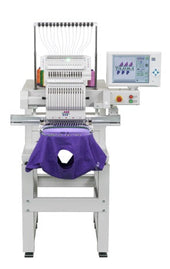
Stop Losing Money: How Industrial Sewing Machines Reduce Waste and Maximise Profits
Many high-volume sewing businesses struggle with hidden costs that chip away at their earnings. These costs often include material wastage, machine downtime, and lost labour hours. You may not notice these problems right away, but they add up over time and reduce overall profit.
We understand how frustrating it can be to see your resources go unused.
Is there something I can do about this?
Yes! This is why we focus on providing helpful advice and tools that can address the root of these problems.
One approach is to invest in industrial sewing machines, which are built for long-lasting performance and cost savings. Keep reading to learn how these machines can help improve day-to-day operations and profits.
What Causes Waste in High-Volume Sewing?
We see many businesses dealing with issues that lead to lost fabric, slower output, and extra costs. If you want to understand why these problems occur, read on for key points that can help you stop money from slipping away.
Material Waste: Why Does Fabric Get Wasted in Mass Production?

Incorrect measurements and faulty cutting methods are frequent reasons for lost fabric. When these mistakes happen on a large scale, the pile of unwanted scraps grows fast.
Another factor is poor pattern layouts, which can leave awkward offcuts that cannot be reused. Over time, these leftover pieces turn into a significant expense, and it becomes clear that a more careful approach is needed.
Machine Inefficiencies: How Do Outdated Sewing Machines Increase Waste?
-
Poor Maintenance: Machines that do not get regular upkeep break down more often and may produce uneven stitches or cuts. This can lead to reworks and lost fabric.
-
Outdated sewing machine parts: Older components can slow down production and create quality issues. Worn gears or belts may cause thread jams and skipped stitches.
-
Frequent Breakdowns: Downtime means missed deadlines and delayed orders. When a machine stops mid-production, it also increases the chances of material wastage.
Labour Inefficiencies: Why Training Matters in High-Volume Sewing?
-
Human Errors: Workers who lack proper guidance may make mistakes in stitching, cutting, or finishing. This can lead to scrapped garments and wasted fabric.
-
Slow Production Speeds: Inexperienced staff may move at a reduced pace, causing backlogs and late deliveries.
-
Lack of Proper Training: Without hands-on sessions, employees may not know how to optimise settings or handle thick and thin fabrics well.
Overproduction & Dead Stock: How Excess Production Hurts Profitability
-
Producing More Than Demand Requires: Some businesses make large batches, hoping they will sell. When items sit in storage, that ties up capital and adds extra holding costs.
-
Leading to Surplus: Extra stock can become outdated or damaged, forcing you to mark down prices or discard leftover items. This cuts into earnings and wastes materials.
How Industrial Sewing Machines Help Save You Money
Many businesses wonder if new equipment is worth the commitment. They can be expensive at first, but they are well worth their price. Read on to see the key reasons you might consider stronger tools for high-volume tasks.
What Are the Functions of an Industrial Sewing Machine?
Precision Cutting & Stitching
Industrial models are built to handle repeated tasks with tight control over stitch length and cutting angles. This keeps seams tidy and fabric edges smooth, helping you reduce errors.
Durability & Performance
These machines are made with sturdy materials that can cope with heavy workloads. You are less likely to face sudden breakdowns because they are designed for tough production demands.
Specialised Machines for Different Needs

Our team provides special machines for leather, denim, and other thick fabrics. Some businesses also rely on embroidery machines or quilting equipment for more complex projects. Each type of machine focuses on a set of tasks that can boost output quality for specific fabric types.
Industrial vs. Normal Sewing Machines?
Domestic machines can be a good fit for small-scale work, but they may struggle with bulk orders or thicker fabrics. Industrial sewing machines offer faster stitching, stronger internal parts, and higher capacity.
These factors help you handle large volumes in less time. They are built to run for many hours at a stretch, which saves money on repairs and replacements.
The Importance of Sewing Equipment in Business Operations
Regular upkeep is the key to smooth production. Tasks like oiling and cleaning are simple yet help keep parts moving. Careful storage also keeps dust or moisture away, which can prevent early wear.
Another factor is using high-quality sewing machine accessories. Cheap tools might seem budget-friendly at first, but they can lead to jams or uneven stitching in the long run.
How Upgrading Sewing Machine Parts Can Improve Efficiency
Replacing worn-out pieces can help you avoid frequent malfunctions and lost work hours. Old bearings, belts, or motors can cause noisy operations, skipped stitches, and errors that ruin garments. By switching to better components, you can raise output speed and reduce fabric waste.
The upfront cost often pays for itself when you consider saved labour time and fewer spoiled materials. This is one of the many reasons our team encourages businesses to look into upgrade paths for their sewing machine parts. Long-term gains often outweigh the initial spending, and you will see a smoother workflow across projects.
Maintenance Tips to Extend the Lifespan of Your Industrial Sewing Machine
Many owners want to get the most out of their tools but overlook small checks that add years to their machines. There are a few points to keep in mind before you run another project. Read on for simple ways to look after industrial sewing machines without major hassles.
How to Avoid Common Industrial Sewing Problems?
Identifying Problems
Issues like thread tension problems skipped stitches, and motor overheating, are some of the most common ones in sewing machines. Tension problems can cause uneven stitches. Improper needle sizes or subpar thread can also lead to skipped stitches. If motors run hot, you might be pushing your machine too hard without breaks.
Preventative Measures
Replacing worn-out sewing machine accessories before they cause bigger issues. Old needles, belts, and bobbins can create more harm than you think. Swapping them out early can prevent broken threads or jammed fabric, which avoids delays in tight schedules.
Ensuring Proper Machine Calibration
Adjusting thread tension, feed dogs, and other settings can keep your work precise. A small tweak can stop repeated mistakes and help your machine run in a stable way.
The Role of a Sewing Equipment Specialist in Optimising Production
A sewing equipment specialist can guide you on the best sewing machines or cutting equipment for your needs. They review your workload, fabric types, and budget to match you with a model that fits your operations.
Their advice can also help you schedule timely check-ups so you do not have to face sudden downtime. By consulting with professionals, you stand a better chance of saving money through reduced waste and fewer breakdowns.
Understanding Industrial Sewing Machines: Key Features & Considerations
Some businesses wonder about energy use, built-in tables, and other product details. We want to address these common questions so you can make a better decision about upgrading to industrial sewing machines. Take a look at these points before you invest in new tools.
How Much Power Does an Industrial Sewing Machine Use?
Industrial models often need a dedicated power source to run at full speed. Some can work on standard outlets, while others call for higher voltage.
If you are setting up a large workshop, it is wise to check the wattage and confirm that your facility can handle the draw. Investing in proper wiring can help you avoid blown fuses and sudden stops.
Do Industrial Sewing Machines Come with a Table?
Many units are sold with a sturdy work surface attached. This setup is handy for steady performance since the table is built to support the machine’s weight.
If you already have a strong table, you can often buy the machine head alone. Either way, keep an eye on the product details, as some packages differ in what they include.
How Much Does an Industrial Sewing Machine Weigh?
They can be heavier than regular machines because they include strong metal frames and motors. The weight can range from 20 kilograms to over 40 kilograms, depending on the model.
A heavier build helps reduce vibration and keep stitches straight, which is helpful in high-speed production. If you want to move your machine often, plan for safe ways to shift it without straining your workers.
What Is the Use of an Industrial Weaving Machine?
While standard models focus on stitching pieces together, a weaving machine creates fabrics or patterns by interlacing threads. This can be helpful when you want to produce material from scratch.
Businesses that handle larger projects sometimes look at weaving tools for custom textile production, making them a separate but related asset for the industry.
Sewing Different Fabrics: Tips & Best Practices

Shoppers who run large-scale projects often ask about how to handle different materials without wasting time or supplies. We have put together some pointers that can guide you on what methods might fit best for your operations.
How to Sew Slippery Fabric Without Wasting Material?
Thin or shiny fabrics can move around if you rely on standard machine settings. Special parts and needles can help secure each layer.
Placing a sheet of tissue paper underneath can also stop the fabric from sliding as you work. These small tricks often save you from tossing aside sections that get bunched up.
How to Sew Stretchy Material Using an Industrial Machine?
Stretchy fabrics can snap threads if you use the wrong stitch. A zigzag or stretch stitch can adapt to the material’s movement.
If you have an industrial machine with adjustable settings, test your tension and stitch length on scrap pieces first. This approach avoids big mistakes once you begin full-scale production.
What Kind of Sewing Machine Do You Need for Leather?
Leather can wear down standard machines with its thickness and tough texture. That is why many professionals recommend industrial sewing machines built with heavier needles, sturdy motors, and strong presser feet.
These machines reduce skipped stitches on thick layers and help you avoid broken parts. If you handle leather regularly, look at special machines tailored for this type of work.
Sew More, Waste Less
High-volume sewing businesses often find themselves losing money because of fabric scraps, machine delays, labour oversights, and surplus production. These hidden costs can balloon if left unmanaged. Our team has seen how minor flaws lead to big expenses over time, which is why we believe in tools that stand up to daily use.
By switching to industrial sewing machines, you can cut back on errors, reduce downtime, and keep your staff working with greater consistency. The result is a smoother flow from start to finish, which saves you money and boosts production levels.
We encourage you to check out Sewingtime NZ’s range of sewing machine accessories and upgrades. We also carry cutting equipment and quilting equipment that cater to different sewing tasks.
When you invest in well-made machines and parts, you set yourself up for better results and healthier profit margins. You will see the difference across your operations, from stitching to final delivery.



